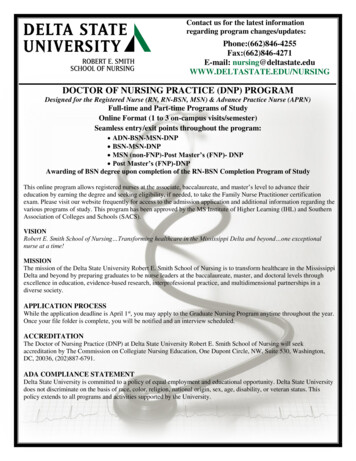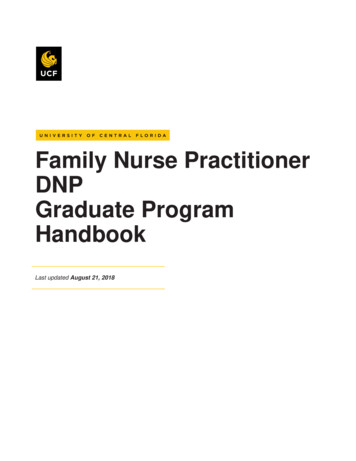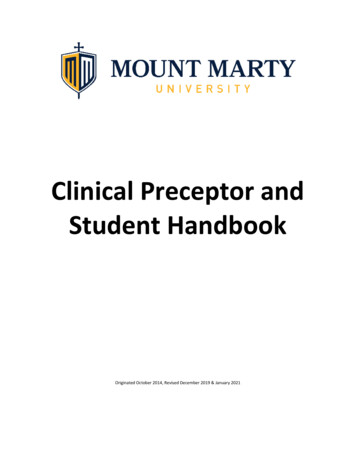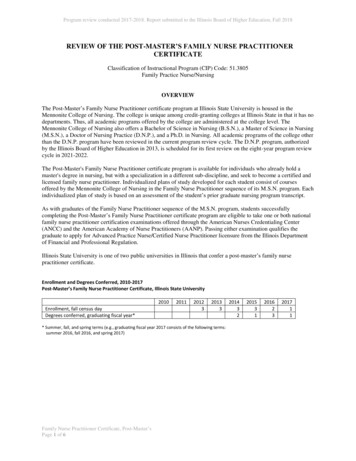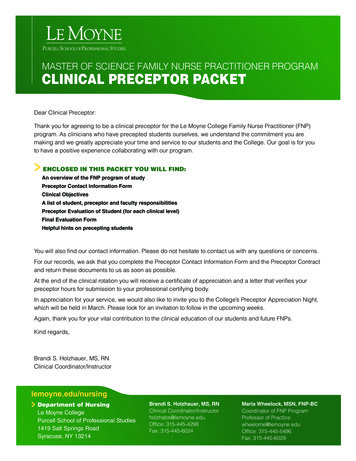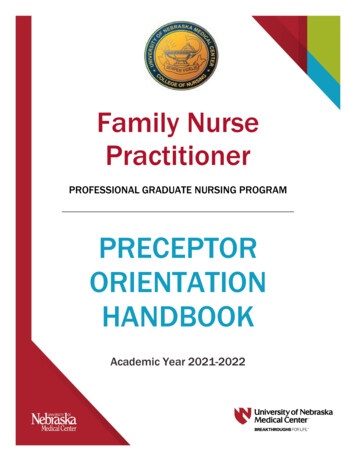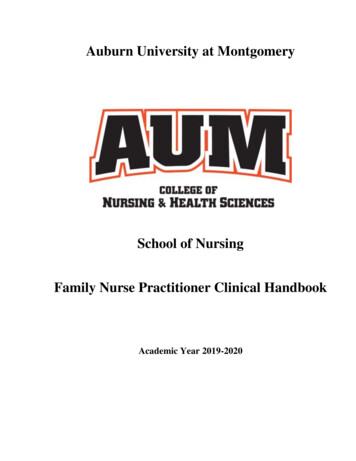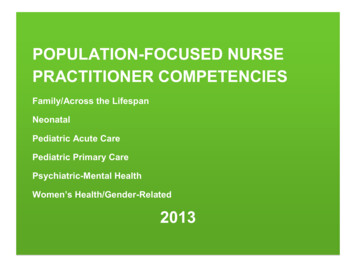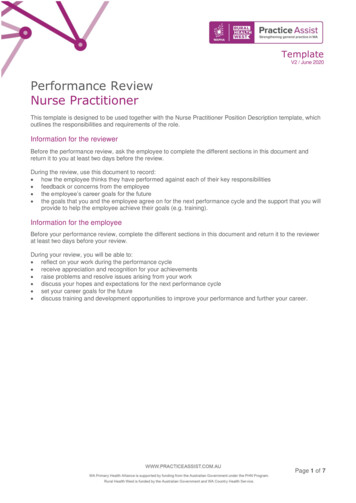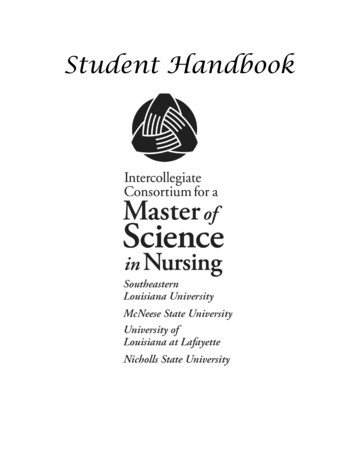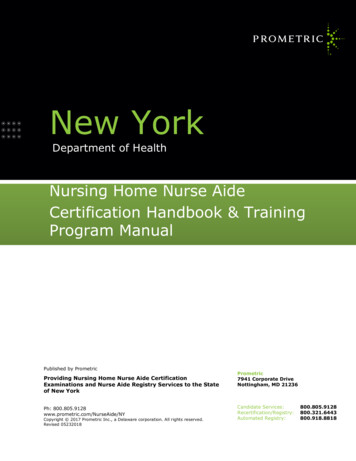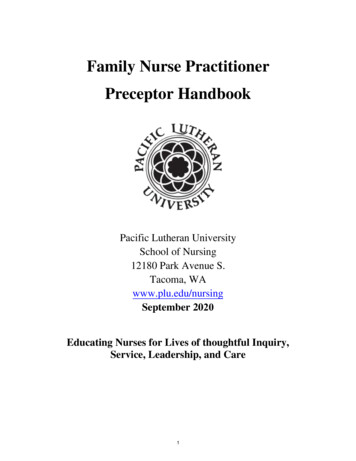
Transcription
Family Nurse PractitionerPreceptor HandbookPacific Lutheran UniversitySchool of Nursing12180 Park Avenue S.Tacoma, WAwww.plu.edu/nursingSeptember 2020Educating Nurses for Lives of thoughtful Inquiry,Service, Leadership, and Care1
Table of ContentsPacific Lutheran University School of NursingMissionGraduate Program OutcomesDoctor of Nursing Practice FNP curriculumAdministration and Support StaffFamily Nurse Practitioner FacultyPg 3Faculty GuidelinesRole and responsibilities of FNP facultyPg 6Preceptor GuidelinesRole and responsibilities of the preceptorPreceptor selection criteriaStrategies for working with studentsOnline precepting resourcesDocumentation of visitEvaluation of studentFilling out PLU clinical evaluation formsPg 8FNP Student GuidelinesRole and responsibility of the studentPg 12ReferencesPg 13Pg 14AppendicesAppendix A: NONPF Nurse Practitioner Role CompetenciesAppendix B: NONPF Family Nurse Practitioner Primary Care specialty competenciesAppendix C: The Five Step Microskills Model of Clinical TeachingAppendix D: NURS 584 FNP I Evaluation FormAppendix E: NURS 585 FNP II Evaluation FormAppendix F: NURS 562 Primary Care Management of Women and Children Evaluation formAppendix G: NURS 594 FNP Capstone Evaluation FormAppendix H: FNP Evaluation Form (2021 Pilot)2
Pacific Lutheran University School of NursingMissionPacific Lutheran University seeks to educate students for lives of thoughtful inquiry, service, leadership andcare—for other people, for their communities, and for the earth.Pacific Lutheran University School of Nursing is dedicated to - Exemplary and responsive undergraduate, graduate, and continuing nursing education;- Engaging clinical and community partners in compassionate care for individuals, families, communities, andthe world;- Fostering leadership in nursing through committed service, highest quality education, and meaningfulscholarship;- Advancing the vision and mission of the university through collaborative partnerships that foster innovationand change.Graduate Program OutcomesThe DNP curriculum is based on the AACN Essentials of Doctoral Education for Advanced Nursing Practice(2006) and prepares nurses to practice at the highest level of advanced nursing practice, as well as provideleadership for practice change to improve patient outcomes. Students will demonstrate outcome achievementthrough their clinical evaluations, projects and coursework. Evidence of achievement is found in their DNPportfolio.Doctor of Nursing Practice FNP curriculumThe PLU Doctor of Nursing Practice (DNP) degree prepares graduates in the advanced practice specialty areaof Family Nurse Practitioner (FNP) or Psychiatric Mental Health Nurse Practitioner (PMHNP). Graduates areable to develop and evaluate quality within a health system, collaborate with inter-professional teams toimprove health outcomes, and be leaders in the nursing profession in addition to practicing independently intheir repective nurse practitioner specialty. The DNP curriculum consists of core coursework (theory, advancedpractice roles, evaluation and outcomes research, leadership and management, and advanced health promotion,information systems and patient care technology, epidemiology, analytical methods, translating research intopractice, and health policy), a DNP Scholarly Project and Nurse Practitioner specialty coursework. The FamilyNurse Practitioner core coursework focuses on client-centered clinical practice, and prepares nurses to respondto the needs of today’s and tomorrow’s health care consumers, to manage direct care based on advancedassessment and diagnostic reasoning, to incorporate health promotion and disease prevention interventions intohealth care delivery, and to recognize their potential for professional growth, responsibility, and autonomy.The FNP curriculum is based on the National Organization of Nurse Practitioner Faculties (NONPF) 2017Nurse Practitioner Role Competencies (Appendix A) and the NONPF Family Nurse Practitioner Primary Carespecialty competencies (Appendix B).3
Successful completion of the DNP Family Nurse Practitioner program qualifies students to sit for nationalcertification examinations for Family Nurse Practitioner, making them eligible under Washington State law forAdvanced Registered Nurse Practitioner (ARNP) licensure.The PLU DNP FNP program requires 36 months of full time study and includes 1080 hours of clinical, with630 hours specific to the FNP specialty role. The PLU DNP program includes clinical experience specific toquality and outcomes at the systems level before they begin the FNP core courses, and 300 hours of clinicalpracticum designing, implementing and evaluating a scholarly project. Scholarly projects will focus onapplying evidence based research into practice, and may be completed in the primary care setting or within ahealth system to improve patient outcomes.Doctor of Nursing Practice Family Nurse Practitioner Curriculum4
Pacific Lutheran University Administrators and Support StaffBarbara Habermann PhD, RN, FAANProfessor and Dean, School of Nursing bhabermann@plu.eduKathleen J. Richardson DNP, RN, ARNP, NP-C, ENP-BC, CEN, FAENAssistant Professor and Associate Dean of Academic Affairsricharkk@plu.eduJennifer Bolin MSN, RNGraduate Clinical Placement Coordinatorbolinj@plu.eduFamily Nurse Practitioner FacultyCarrie Ann Matyac DNP, RN, ARNP, FNP-BCAssistant Professor, FNP Program Coordinator/Lead Facultymatyacca@plu.eduCheryl Graf MSN, RN, ARNP, FNP-BCClinical Instructorgrafca@plu.eduLorena Guerrero PhD, RN, ARNP, FNPAssistant Professorguerrelc@plu.eduSheree Harvey DNP, RN, ARNP, FNP-BCClinical Instructorharveys@plu.eduSheree Harvey DNP, RN, ARNP, FNP-BCClinical Instructorharveys@plu.eduRichard Knowlton DNP, RN, ARNP, FNPAssistant Professorknowltrt@plu.eduMolly Martin DNP, RN, ARNP, FNP-BCClinical Instructormartinmj@plu.eduJonathan Raffesberger DNP, RN, ARNP, NP-CClinical Instructorjonathan.raffesberger@gmail.comJessica Schwinck DNP, RN, ARNP, AGACNP-BC, FNP-BCAssistant Professorschwinjl@plu.edu5
Faculty GuidelinesRole and responsibilities of FNP facultyThe PLU faculty member teaching a FNP clinical course (course lead) assumes all responsibility for thedidactic and clinical components of the course. Responsibilities of the FNP course lead faculty include: Orientation and training of clinical facultyOversight of clinical facultyEnsure all documents completed and submittedEnsure course, clinical, preceptor and clinical site evaluations completed and submitted at the end of thecourseComplete a course evaluation to inform future offeringsReport any student performance concerns to the program directorAssign students to specific preceptorsOrient preceptors to the coursePerform clinical site visitsMaintain open lines of communication with preceptors and clinical sites, and supervising student learningClinical placement coordinatorThe clinical placement coordinator maintains contracts, Clinical site/preceptor database and coordinates,clinical placements and student onboarding. The lead course faculty will work with the clinical placementcoordinator to identify/secure clinical site placements and preceptors for students and verifying clinical contractis current,.Clinical sites and preceptorsPLU SoN seeks clinical site placements and preceptors to ensure the best possible experiences for the FNPstudent. Each preceptor and clinical site enters into a contractual agreement with the PLU School of Nursingfor the student's clinical rotations. All students are covered by the PLU School of Nursing liability insurancethrough American Casuality Company of Reading, Pennsylvania. It is the responsibility of the clinicalplacement coordinator and PLU faculty teaching a clinical course to ensure the clinical contract is in placebefore students begin clinical hours for the semester.Assigning students to preceptorsStudents are assigned to a preceptor by the FNP program director, in consultation with FNP faculty, to provideclinical rotations focusing on course outcomes and individual student learning needs. Occasionally students willrequest a specific site or preceptor. Typically, students are not placed with preceptors that have previousrelationships with the student. It is the responsibility of the faculty to discuss with the student their educationalneeds and how the site will meet the objectives of the course before determining if the site is appropriate for thestudent. Students should not be arranging clinical placements directly with the preceptor and any student doingso should be directed to the lead faculty for the course.6
Orienting preceptorsPreceptors are oriented individually via conversations with FNP Course lead and clinical faculty, ongoing email, face-to-face meetings, and the PLU FNP Preceptor Manual. Communication occurs throughout eachsemester as needed. Preceptors are mailed a copy of the preceptor handbook, course syllabus, evaluation forms,clinical agreement letter, and an overview of the PLU FNP curriculum each semester.Supervision of clinical learningFNP clinical faculty formally visit each student in their clinical site a minimum of once a semester to observeclinical progress. If needed, the faculty will visit the student multiple times during the semester to assist thepreceptor and monitor the student clinical performance. All FNP faculty are responsible to review theelectronic/paper Student Tracking System logs to assess assigned student progress toward attainment of clinicalobjectives for the course and to determine if students are getting the clinical experiences to meet the NONPFFNP competencies. Course lead faculty are responsible to ensure training and oversight of clinical faculty.7
Preceptor GuidelinesThe PLU School of Nursing recognizes the critical role preceptors play in the education of our FNP students.Preceptors provide advanced knowledge and skills that assist our FNP students to develop into advancedpractice nurses.Role and responsibilities of the preceptorThe primary role of the preceptor is one of clinical instructor, coach, supervisor and evaluator. Nursepractitioner preceptors also act as role models and socialize the student to the nurse practitioner role (Ulrich,2011). Preceptors assist the student in incorporating knowledge learned in the classroom into the clinicalmanagement of patients. The preceptor provides instruction as the student observes and then gradually becomesresponsible for assessment, diagnosis, treatment, health care evaluation and monitoring, health promotion andcounseling that form the basis of FNP practice.Specific preceptor role responsibilities Negotiate dates and times for student clinical experiences and notifies the student if they are unable to bepresent. If preceptor is unable to be present for an arranged clinical day they may arrange for a qualifiedsubstitute or reschedule with the student.Provide orientation to the clinical site and health record the student’s first week.Orients student to policies, operational procedures and protocols specific to the clinical site.Reviews course objectives and student goals for clinical experience and negotiates with the student howthey will meet the objectives.Be available to the student at all times the student is seeing patients.Selects, with the student, patients appropriate to meet clinical objectives for the day and semester.Intervenes where appropriate to manage situations beyond the student’s ability.Evaluates student’s care while providing immediate feedback and cosigning all charts.Evaluates the student verbally and in writing.Contact faculty if there are problems with student.Qualities that make Super Preceptors (Barker & Pittman, n.d.)Professional Characteristics Willing to work with a student who is aneophyte as well as more advancedstudents Supportive of the student’s educationalprogram Current knowledge and skills Models appropriate behaviors and attitudes Willing to give constructive feedback Supports student growthPersonality characteristics Empathetic Warm Respectful Sense of humor Flexible Fair Dependable Consistent8
Preceptor selection criteriaAll preceptors are considered to be experts in their area of practice, with a minimum of one year of clinicalpractice experience. Preceptors may be nurse practitioner, physician assistants, or physicians with clinicalpractice expertise, teaching skills and the willingness to be a preceptor to an FNP student. Preceptors must becurrently licensed to practice and certified in their practice specialty. PLU maintains a record of preceptorcurriculum vitae (CV), including professional practice experience for accreditation purposes; therefore we askthat all preceptors submit their current CV.Strategies for working with studentsPrecepting students is a skill as well as a relationship. This section of the manual provides strategies forworking with nurse practitioner students. Resources are provided in the reference list for more in-depthpreceptor education, including a link to the American Association of Nurse Practitioners Preceptor Toolkit fromwhich many of these strategies are taken.Orientation strategiesTo establish a quality preceptor-student relationship it is recommended that the student has a formal orientationto the practice and their preceptor’s practice style. Set aside time for orientation at an hour that works to cause the least disruption to the practice flow. Lengthof orientation will vary by the setting, but usually an hour or less. Introduce the student to clinic staff and key personnel. Discuss “ground rules” including patient selection, protocols or policies specific to setting Explain your process for precepting including how you will introduce the student to patients and how youwill be checking their physical examination findings Get to know the student Have them shadow you for the first half day in clinic together so they understand the flow of visitsAssisting students to learn in the clinical setting Create an environment that is conducive to learningo Students are often anxious in the beginning of each clinical experienceo Seek appropriate patients for the student’s level of experienceo Give constructive positive feedbackDemonstrate new skills or bring students in on complicated patients you see to provide an example of howyou approach the patient“Think aloud” as you reason through a complex patient you are seeing to role model clinical decisionmakingAssign readings or resources you have found helpfulUse charting to teach.9
Direct students to think about their patient encounterso Ask them what they think is going on with the patiento Ask for supporting evidence. What in the history or exam lead to the conclusion?o Assist them in broadening their differentialReinforce what they do right. “You did an excellent job of .”Correct mistakes. “Next time this happens, try .”Try the “Five-step Microskills Model of Clinical Teaching” to direct the discussion and use your timeefficiently (see Appendix C)Suggestions for managing patient flow while precepting Look at schedule ahead of time and plan which patients the student may seeAllow time for the student to thinko Have the student see a patient while preceptor sees another patiento Student presents history and physical to preceptoro Preceptor sees patient to confirm findingso While preceptor seeing patient, student develops plano Students presents plan to preceptoro Student and preceptor returns to room to communicate plan to patiento Student charts encounter while preceptor sees next patiento When charting complete, student sees another patientStudents may only see 4 patients a day in the beginning of a semester and build up to 10 a day at the end oftheir program depending on the complexity of the patient.Barker and Pittman recommend occasionally scheduling “focused half days” where there is a specific focusto the learning, diabetes or COPD for example. The student spends time before and after the visit readingthe chart of 2 or 3 patients and reviewing guidelines for management and only sees the patients withdiabetes or COPD that half day. The preceptor sees the rest of the patients and then can focus their teachingtime on diabetic or COPD management. The focus can be either tied to what the student is learning thatweek in class or an area they find challenging.Online Precepting ResourcesThe National Organization of Nurse Practitioner Faculties offers online brief video vignettes that may be usefulto preceptors (http://www.nonpf.org/?page Preceptor Vignettes) or go to the nonpf.org site and the Educationtab to find preceptor info.Vignette topics include “Precepting in a Busy Clinic” “Precepting the Primary Care NP Student” “ Preceptingthe Overly Confident NP Student” “ Precepting the Overly Sensitive NP Student”10
Documentation of visitStudents may document in the patient chart their history, physical, assessment and plan for the patient.Preceptors need to document in the patient’s note that they were present for or conducted themselves(rechecked the student’s findings) the key portions of the history and physical, as well has helped the studentdevelop the plan of care. This will ensure you comply with Medicare/Medicaid billing rules.Evaluation of studentHonest student evaluations are critical for the student, faculty and the patients the student will be caring for.Evaluation can be formal or informal. Formal written evaluations should be done at mid-term and the end ofthe semester. Evaluation forms are provided to preceptors and are found in the Appendix. Informal evaluationoccurs throughout the semester and is part of a supportive learning environment.Constructive evaluation is: HonestTimelyBased on skill development. Don’t expect a student to know they have a skill deficit if you don’t tell themabout it. Tell them, teach them and let them learn.Based on student’s level. Remember where they are in their program before evaluating them.Specific rather than generalPositive as well as negativeDealing with difficult studentsWhile each student who enters the graduate program is highly qualified academically, the role transition toadvanced practice nurse may be challenging for some. Identify any professional or boundary issues early andcommunicate them to the student with expectations for change. Failing students often lack insight, thereforethey need direct communication regarding their progress. Seek the assistance of the faculty as appropriate.If you have concerns about a student: Communicate early with the faculty and the student Document any concerns you may have in the formal evaluation Trust your judgmentFilling out PLU clinical evaluation formsHonest preceptor feedback is critical to the student, the faculty, and to the role of the ARNP. The clinicalevaluation tool is designed to give feedback to the student at midterm and at the end of the semester. Studentsare expected to progress in skill and knowledge development throughout the program, so lower marks areexpected at midterm than at the end of the semester.When filling out the clinical evaluation tool, note the course level where the faculty expect the student to be atthe end of the semester. If you have concerns about student progress at any time during contact the clinicalfaculty via email as soon as possible. (Appendix D-H)11
FNP Student GuidelinesRole and responsibility of the studentClinical PlacementsPLU faculty seek clinical site placements and preceptors to ensure the best possible learning experiences forthe FNP student. Students are assigned to a preceptor by the FNP program director in consultation with FNPfaculty to provide clinical rotations focusing on course outcomes and individual student learning needs. leadFNP faculty member. Occasionally students may request a specific site or preceptor. It is the responsibility ofthe faculty member to discuss with the student their educational needs and how the site will meet the objectivesof the course before determining if the site is appropriate for the student. Students should not be arrangingclinical placements directly with the preceptor.Pre-clinical preparationAll students are required to complete the requirements for being in the clinical site including immunizations,CPR, proof of Washington RN license, criminal background check, and any additional clinical siterequirements. Students should be able to present their clinical passport to the agency to provide proof of beingcleared for clinical.Clinical attireStudents are to wear their PLU student photo ID at all times while in the clinical site. Some agencies requireadditional agency identification and students should follow all agency identification requirements.Students should wear their white lab jacket while seeing patients, unless directed otherwise by the clinicalpreceptor or agency. Students must exercise good personal hygiene and present themselves in clean, wellfitting, clothing that is professional in appearance.Preparation for clinical learningStudents are expected to come to the clinical site prepared to learn. At the beginning of the semester studentsshould review the clinical course objectives as well as the evaluation form for the specific clinical course thepreceptor and faculty will be using for evaluation. Students should review with preceptors any additionalindividual learning objectives they may have, providing an opportunity to discuss expectations andresponsibilities of each.Because each preceptorship experience is unique, the student should be prepared to research disease processesand treatments that present themselves during the clinical day. Students should be prepared to access clinicalresources such as text books or on-line evidence based databases in order to provide excellent patient care.Recording clinical experiencesFNP students document their clinical experiences and hours in the Typhon NPST Student Tracking System.Typhon enables tracking of clinical hours, the age and diagnosis for each patient to ensure the FNP studenthas seen patients across the lifespan and having a range of preventive health, acute and chronic illness visitsand procedures. The student will present a copy of their clinical hours log to the preceptor for their signatureat the end of the semester for approval.12
ReferencesBarker, ER & Pittman, O (n.d.) Preceptor Toolkit. American Associate of Nurse Practitioners. Retrieved /PreceptorToolkit.pdfBott, G., Mohide, E. I., & Lawlor, Y. (2011). A clinical teaching technique for nurse preceptors: The fiveminute preceptor. Journal of Professional Nursing, 27(1), 35-42.Parrott, S, Dobble, A., Chumley, H. & Tysinger, JW (2006). Evidence-based office teaching—The five-stepmicroskills model of clinical teaching. Family Medicine, 38(3), 164-7.Neher, JO & Stevens, NG (2003). The one-minute preceptor: Shaping the teaching conversation. FamilyMedicine, 35(6), 391-3.Training the trainer: Tips for Nurse Preceptors. http://tipsfornursepreceptors.blogspot.com/Ulrich, B. (2011). Precepting—A key nursing role. Nephrology Nursing Journal, 38(3), 225.Ulrich, B (2011). Mastering Precepting: A Nurse’s Handbook for Success. Sigma Theta Tau International.13
APPENDIX ANational Association of Nurse Practitioner FacultiesNurse Practitioner Core Competencies (2017)Scientific Foundation Competencies1. Critically analyzes data and evidence for improving advanced nursing practice.2. Integrates knowledge from the humanities and sciences within the context of nursing science.3. Translates research and other forms of knowledge to improve practice processes and outcomes.4. Develops new practice approaches based on the integration of research, theory, and practiceKnowledgeLeadership Competencies1. Assumes complex and advanced leadership roles to initiate and guide change.2. Provides leadership to foster collaboration with multiple stakeholders (e.g. patients, community, integratedhealth care teams, and policy makers) to improve health care.3. Demonstrates leadership that uses critical and reflective thinking.4. Advocates for improved access, quality and cost effective health care.5. Advances practice through the development and implementation of innovations incorporating principles ofchange.6. Communicates practice knowledge effectively both orally and in writing.7. Participates in professional organizations and activities that influence advanced practice nursingand/or health outcomes of a population focus.Quality Competencies1. Uses best available evidence to continuously improve quality of clinical practice.2. Evaluates the relationships among access, cost, quality, and safety and their influence on health care.3. Evaluates how organizational structure, care processes, financing, marketing and policy decisions impact thequality of health care.4. Applies skills in peer review to promote a culture of excellence.5. Anticipates variations in practice and is proactive in implementing interventions to ensure quality.Practice Inquiry Competencies1. Provides leadership in the translation of new knowledge into practice.2. Generates knowledge from clinical practice to improve practice and patient outcomes.3. Applies clinical investigative skills to improve health outcomes.4. Leads practice inquiry, individually or in partnership with others.5. Disseminates evidence from inquiry to diverse audiences using multiple modalities.6. Analyzes clinical guidelines for individualized application into practiceTechnology and Information Literacy Competencies1. Integrates appropriate technologies for knowledge management to improve health care.2. Translates technical and scientific health information appropriate for various users’ needs.2a). Assesses the patient’s and caregiver’s educational needs to provide effective, personalized health care.2b). Coaches the patient and caregiver for positive behavioral change.3. Demonstrates information literacy skills in complex decision making.4. Contributes to the design of clinical information systems that promote safe, quality and cost effective care.5. Uses technology systems that capture data on variables for the evaluation of nursing care.14
Policy Competencies1. Demonstrates an understanding of the interdependence of policy and practice.2. Advocates for ethical policies that promote access, equity, quality, and cost.3. Analyzes ethical, legal, and social factors influencing policy development.4. Contributes in the development of health policy.5. Analyzes the implications of health policy across disciplines.6. Evaluates the impact of globalization on health care policy development.7. Advocates for policies for safe and healthy practice environments.Health Delivery System Competencies1. Applies knowledge of organizational practices and complex systems to improve health care delivery.2. Effects health care change using broad based skills including negotiating, consensus-building, and partnering.3. Minimizes risk to patients and providers at the individual and systems level.4. Facilitates the development of health care systems that address the needs of culturally diversepopulations, providers, and other stakeholders.5. Evaluates the impact of health care delivery on patients, providers, other stakeholders, and the environment.6. Analyzes organizational structure, functions and resources to improve the delivery of care.7. Collaborates in planning for transitions across the continuum of care.Ethics Competencies1. Integrates ethical principles in decision making.2. Evaluates the ethical consequences of decisions.3. Applies ethically sound solutions to complex issues related to individuals, populations and systems of care.Independent Practice Competencies1. Functions as a licensed independent practitioner.2. Demonstrates the highest level of accountability for professional practice.3. Practices independently managing previously diagnosed and undiagnosed patients.3.a Provides the full spectrum of health care services to include health promotion, disease prevention, healthprotection, anticipatory guidance, counseling, disease management, palliative, and end-of-life care.3.b Uses advanced health assessment skills to differentiate between normal, variations of normal and abnormalfindings.3.c Employs screening and diagnostic strategies in the development of diagnoses.3.d Prescribes medications within scope of practice.3.e Manages the health/illness status of patients and families over time.4. Provides patient-centered care recognizing cultural diversity and the patient or designee as a full partner indecision-making.4.a Works to establish a relationship with the patient characterized by mutual respect, empathy, andcollaboration.4.b Creates a climate of patient- centered care to include confidentiality, privacy, comfort, emotional support,mutual trust, and respect.4.c Incorporates the patient’s cultural and spiritual preferences, values, and beliefs into health care. duplicate.4.d Preserves the patient’s control over decision making by negotiating a mutually acceptable plan of care.4e. Develops strategies to prevent one’s own personal biases from interfering with delivery of quality care.4f. Addresses cultural, spiritual, and ethnic influences that potentially create conflict among individuals,families, staff and caregivers.5. Educates professional and lay caregivers to provide culturally and spiritually sensitive, appropriate care6. Collaborates with both professional and other caregivers to achieve optimal care outcomes.7. Coordinates transitional care services in and across care settings.8. Participates in the development, use, and evaluation of professional standards and evidence-based care.15
APPENDIX BNational Organization of Nurse Practitioner Faculties: Family Nurse Practitioner RoleCompetencies (2013/17)Upon graduation or entry into practice, the family nurse practitioner should demonstrate competence in thecategor
practice, and health policy), a DNP Scholarly Project and Nurse Practitioner specialty coursework. The Family Nurse Practitioner core coursework focuses on client-centered clinical practice, and prepares nurses to respond to the needs of today’s and tomorrow’s healt
